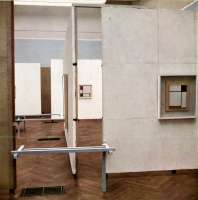The history of the white cube, once incontrovertibly identified with the myth of modern art, is becoming ever more complicated and more ramified, as competing storylines abound and genealogies are no longer so certain. A reconsideration of the field of exhibition studies is already well underway and has helped to unearth a wealth of prewar experiments in museology in such places as Weimar Germany (Hanover, Hamburg, Dresden, and Essen), led by such figures as Alexander Dorner, Ludwig Justi, Karl Schneider, Lily Reich, and Karl Osthaus. The historical avant-gardes produced alternatives to the white cube—think of Piet Mondrian’s Salon de Mme B in Dresden in 1926, El Lissitzky’s Kabinett der Abstrakten (Abstract cabinet), commissioned by Dorner in the same year, Frederick Kiesler’s experiments in Europe and in the United States, or the exhibition apparatuses planned by the Russian and Soviet avant-gardes in the first half of the twentieth century. But their reappearance in the historical record has happened only belatedly and remains partial. The museum’s own case-based approach explains some of the difficulty of capturing institutional agency in art, as historians have not kept up with artists in interrogating the romantic trope of art-making as a solitary activity and in questioning every activity artists are asked to perform, including the organization and hanging of exhibitions. Furthermore, as Maria Gough reveals in work on the Kabinett der Abstrakten and on constructivist models in general, restitching the connective tissue of modernist museology after the First World War requires a resolutely international and pluralistic approach. Yet art-historical approaches to the modern art museum and its modes of exhibition since the 1990s have remained largely regional in both their objects and their references.
One country that has been effectively marginalized in the study of the apparatus of art is Italy. Studying the exhibition systems and museums that were invented over the course of fifteen years after World War II by those who rebuilt Italy’s museums (including architects, art historians and critics, artists, directors, and superintendents) captures precisely that aspect of the museum apparatus that has hitherto escaped art historians: its collective dimension, its generation from complex interactions among several protagonists. An entire cast of museum directors or superintendents, and especially women such as Genoa’s Caterina Marcenaro and Milan’s Fernanda Wittgens, turned the cranks of the postwar bureaucratic machine. They have remained unstudied in the history of museums and exhibitions because they are outside the modalities of canonization. Traces of collectivity are to be found not in the “white cube” but in the “grey writing”—that is, in bureaucratic paperwork.
TO ACCESS THE FULL TEXT, PLEASE CLICK THE “DOWNLOAD PDF” LINK


